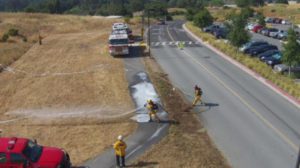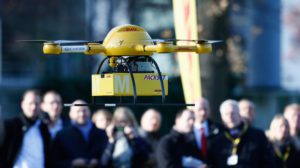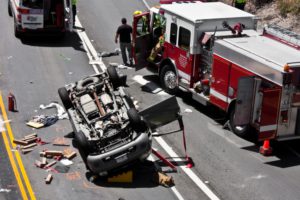— What to Consider Before Buying
Novice, expert or professional, what should you consider?
Drones are some of the most exciting and innovative pieces of technology in 2021. Drones let you survey your surroundings from above and provide a new aerial perspective never seen before, unless you have access to your own helicopter! Whether you are a novice, expert or professional, these flying machines are now relatively affordable compared to the alternatives. Now is the best time to take to the skies and grab those classic images. (And, we suggest you shop early this Holiday season as the drone supply chain has been severely constrained by chip shortages, labor shortages, cargo ships stuck in ports and overall delays across the board).
There is much to learn as you begin your search for the perfect drone, such as, what makes up the drone and how does it fly? Which model is best for my level of expertise? How do I choose the best software and control platform?
This guide will provide some basic considerations that will help you make the best choices for a drone and accessories. We will also recommend some drone models for beginners, professionals and those wishing to delve into drone racing.
Basic Considerations When Choosing a Drone
Regardless of how you plan to use your drone, some basic considerations should be reviewed before any purchase. Take some time to think about how you plan to use your drone, your location or where else you want to use a drone, your current skill level and more. Carefully review the list below and make some notes before you begin shopping.
- Flight time: This varies between the different types of drones and should be taken into account depending on how you intend to use your drone.
- Batteries: Battery power time and how many is enough?
- Flight range: The FAA requires line of sight to your drone.
- Cameras: Is 4K, 20 MP images what you want? Are you advanced and planning to pursue professional images such as thermal, or LiDAR?
- First person view (FPV): Do you plan to start drone racing or specialized cinematography?
- GPS: If you don’t want your drone stuck in a tree, this is good to have.
- Repairs: If I crash, where can I get it repaired and how much will it cost?
- Speed: Most photos and videos don’t require speed, but rather a cinematography touch; however, FPV drones throw all of these thoughts out the window.
- Made in the USA: This is becoming very common with Government concerns over our critical infrastructure.
- New FAA regulations: FAA Remote ID. Manufacturers must be in compliance 18 months after the rule’s original effective date of March 16, 2021, which is September 22, 2022. Operators have until September 16, 2023.
Budgeting and Planning for Your Drone
Two important questions to consider that will help you balance your shopping choices are:
- What is my budget for a drone?
- How do I plan to use a drone?
A large budget to play with is no reason to begin with an extravagant drone. A novice user should always start small, learn the rules and regulations and get some basic practice before you lose signal and potentially crash into the closest tree. By the way, if you do get stuck in a tree, here are some great tips for retrieving your drone!
Affordable Beginner Drones
There are plenty of drones under $100, but most do not come equipped with GPS, so they are frustrating to fly and this will likely be a quick demise for your drone. If you are going to capture your latest vacation shots, here are a few great inexpensive ($99 to $499) starter drones to test the skies. We recommend these, especially because they come equipped with GPS for stellar control.
DJI Tello
The Tello is widely used indoors and by STEM students we teach, and offers the following intro features to get you started:
- Auto Takeoff/Landing: Lift off or land with a single tap
- Low Battery Protection: Alerts go off when your battery gets low
- Failsafe Protection: Land safely, even if you lose connection
- Vision Positioning System: Downward-facing camera that facilitates precise hovering
One word of caution: be careful with the Tello in heavy winds outdoors, as it is very lightweight and will have a tendency to fly away in large gusts.
Autel Nano, Nano+ and Lite
Recently announced the Autel Nano Collection is positioned to take on the much more expensive drones in an inexpensive, compact frame. EVO Nano+ has packed a 1/1.28-inch(0.8-inch) CMOS sensor capable of 50 MP photos. A RYYB color filter array design with a large aperture of f/1.9 offers superior noise reduction capabilities and the power to effortlessly produce quality images in low-light conditions. This drone is fantastic for night flights but please make sure you have proper strobe lights attached for night flights.
Track fast-moving subjects with incredible precision through PDAF + CDAF autofocus system; Squeeze rich detail from shadows and highlights no matter how extreme the lighting conditions using HDR mode, which rapidly snaps several photos at different exposures so they can be stitched together in post-production.
DJI Mini 2
The DJI Mini 2 is just a bit more expensive but is a very popular beginner drone. The DJI Mini 2 is beginner-friendly, powerful and it promises impressive performance, stunning image quality, and creative videos that any novice can learn with just a few taps of the controller. Explore an entirely new perspective, capturing the moments that make your life truly yours.
- Ultralight & Foldable
- 31-Minute Max Flight Time
- 10km Video Transmission
- Level 5 Wind Resistance
- Ultra-Clear 4K Video
- Intelligent Modes & QuickShots
Drones for Experts & Professionals
If you are a drone professional with expert-level training and experience, you should invest in the best possible drone platform that fits your specific business needs. Many commercial industries are incorporating drones into their operations, including real estate, insurance inspectors and adjusters, digital marketing firms, construction management, land mapping, surveying, agriculture management, power line inspection, cell tower inspection, gas pipeline inspection, search and rescue operations and more.
We recommend the following drone models for advanced users and professional operations:
- Autel EVO II 6K, 640T, and Dual (the Autel collection can be found here)
- DJI Mavic 2 Enterprise Advanced
- DJI Mavic 3
- DJI Matrice M300 RTK – Be sure to select the right sensor for your needs, as there are many. Here is some guidance.
Drone Technology Recommendations
The holidays are a great time for drone shopping. In addition to choosing a new platform, you should also examine the new technology becoming available for different drone applications. We recommend:
Mapping software is a very popular platform addition for many drones. Note — if you plan to add drone mapping to your commercial repertoire, you need a Part 107 license from the FAA. You can also visit this link for loads of information about commercial drone mapping, including case studies for different uses, common terms to learn and more. We recommend these top five mapping software platforms for your review:
FPV Drone Racing
By now you have probably seen one of the fastest growing sports in the world known as FPV Racing on ESPN. For those new to the concept, Flying First Person View (FPV) Racing uses drones equipped with onboard cameras that relay live video back to the operator via goggles, mobile phone or tablet screen. Operators guide their drones via the live video feedback through a set, three-dimensional course at speeds reaching 120 mph.
The good news is, this fast-growing sport is available to any common drone racer. According to the Drone Racing League, “You will find FPV meetups all over the country. MiniQuadClub.com, FPVlab.com and FPVRacing.tv are great places to start. Racing can consist of a formal competition like DRL, a few friends getting together in a field, or just freestyle flying – doing tricks and then sharing the videos online. Tracks can be roped off and laid out using trees, flags or poles, or even hula hoops or pool noodles.”
And beginner racing drones are not terribly expensive. Of course, your specific costs will depend on how you want to begin. Most estimates place beginner FPV Racing outfitting at between $800-$1,000, and most of that is one-time investments in FPV goggles, radio, drone and other tools.
Building or buying your FPV Racing drone is also a consideration. Most choose to buy an existing drone model and add modifications as needed. More serious racers may choose to purchase individual components and build a custom racing drone that best fits their skills and needs.
We recommend these five models for different levels of FPV Drone Racing:
- DJI FPV Drone Combo
- Walkera F210 Professional Racer
- Arris X-Speed 250
- Rise Vusion 250
- Arris FPV250
- LHI Full Carbon Fiber 250
Top considerations when choosing a drone for FPV Racing include:
- Indoor or outdoor use
- Open body or closed body (waterproof)
- Carrying ability / mountings for heroes or other equipment
- Cameras
- Motor sizes / power / speed
- Open or enclosed props for maneuverability
Contact 1UP Drones for all your holiday drone shopping questions and options. We can also hook you up with drone training, specific professional training, drone defense measures and more.


